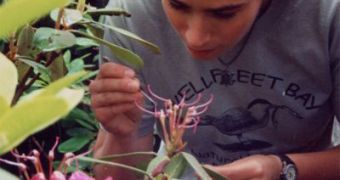Biologists had been wondering for some time whether plants can be classified in species in the same way as animals can. The problem is that many plants seem to be notoriously "promiscuous", having little problem in crossing with other plant "species".
But what is a species exactly? Why a baboon and a wolf are two different species, but a Chihuahua and a Saint Bernard are both the same species (dogs)? The definition used by biologists is this: Two animals are the same species if they can have a fertile offspring. So, for example a horse and a donkey do not belong to the same species because their offspring (a mule) is infertile (cannot have any offspring).
This definition is a little bit tricky because it seems to imply that two males cannot belong to the same species. But in fact they can, because for instance male A could have a fertile offspring with female B, and male C could also have a fertile offspring with the same female B. So, because A belongs to the same species as B, and C also belongs to the same species as B, it means that A and C belong to the same species. In other words, it is assumed that the idea of "belonging to a certain species" is transitive.
However, this definition has been challenged to a certain degree by plants. Scientists have been wondering whether the plant "species" are "real". If plants could cross with each other, the idea of plant "species" would be only in the eye of the beholder. What happens in case of some plants is that the offspring of such a crossing further reproduces asexually (it's like a mule producing another mule by itself without any contribution from some other mule).
But Indiana University Bloomington scientists have analyzed 882 plant and animal species and 1,347 inter-species crossings - the first large-scale comparison of species barriers in plants and animals - and have shown that in fact plant species are just as easily categorized as animal species. Their study delivered quite a surprise showing that hybrid offspring of different animal species are more likely to be fertile than the hybrid offspring of plant species.
"Not only are plants just as easily subdivided into species as animals; when analyzed statistically, plants are more likely to be reproductively isolated due to hybrid sterility," said evolutionary biologist Loren Rieseberg, who led the study. "Most plant species are indeed 'real.' The problem has been that botanists have been way over-attracted to the plant species that readily hybridize and where the hybrids perpetuate themselves asexually. While it's true that dandelions and blackberries [and oaks] pose problems, these horror stories only make up 1 percent of the whole."
Rieseberg and his co-authors, doctoral student Troy Wood and postdoctoral research associate Eric Baack, have examined hundreds of peer-reviewed papers reporting the measurement of various plant and animal characteristics, or reporting on the success or failure of hybridization of plant and animal species with similar species.
After analyzing the hybridization data, the scientists found that only 30 percent of the approximately 500 plant species they surveyed are able to produce fertile hybrids when mated with other species. By stark contrast, 61 percent of animal species surveyed are able to reproduce successfully with other species.
Besides man-made animals such as mules or lingers (lion-tiger hybrids), there are many bird and fish species that successfully hybridize in the wild. The scientists found that birds were most likely to produce fertile hybrids when crossed with other bird species. Ferns, of all things, were least likely to generate fertile hybrids.
This shows the limits of the theoretical definition given above. In nature species are not separated by such sharp boundaries as biological classifications often seem to leave the impression. In fact, there exists a continuous realm of species. This is because all these species evolved through a process of natural selection which is gradual - it isn't like a species suddenly jumps into becoming another completely different species. The transitivity mentioned above does not hold all the way, it isn't objectively true - it only provides some classification guidelines.
For a long time, biologists classified living beings into species either using the above definition or by using more intuitive means - such as observing certain similarities of traits and dubbing some of them more important than others (this method is called "numerical taxonomy"). Reisenberg and his colleagues wondered how accurate these intuitive classifications are.
"These discussions should have been settled earlier, but no one bothered to summarize the relevant literature, perhaps because it is so vast," Rieseberg said. "After going through all this literature, we realized someone just needed to compile and analyze it all."
Their analysis showed that, maybe surprisingly, taxonomists have done a fairly good job at classifying species based on looks rather than on hybridization studies.

 14 DAY TRIAL //
14 DAY TRIAL //